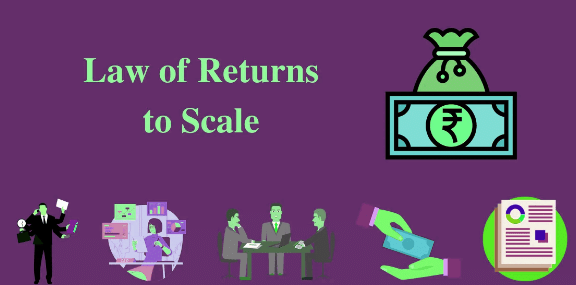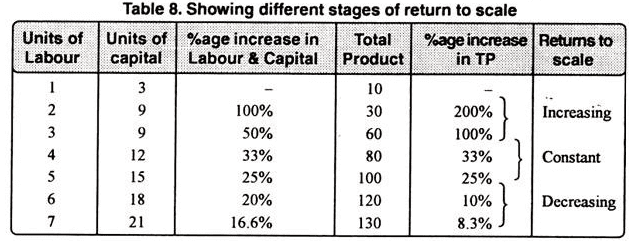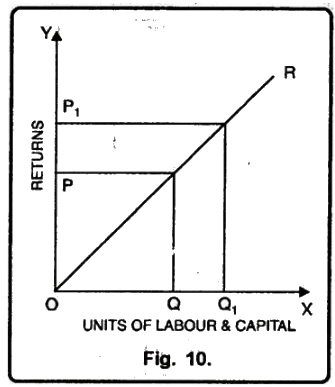Law of Returns to Scale | Crash Course for UGC NET Commerce PDF Download
| Table of contents |

|
| Law of Returns to Scale |

|
| Definition |

|
| Types of Returns to Scale |

|
| Constant Returns to Scale |

|
Law of Returns to Scale

Law of Returns to Scale refers to how the output changes when all factors of production are altered proportionately in the long run.
Definition
- The term "returns to scale" denotes the variations in output when all factors change by the same proportion. - Koutsoyiannis
- It signifies the behavior of total output when all inputs are modified, a concept applicable in the long run. - Leibhafsky
Types of Returns to Scale
- Increasing Returns to Scale: This occurs when increasing all inputs by a certain percentage results in a more than proportional increase in output, indicating economies of scale.
- Constant Returns to Scale: Here, a proportionate increase in all inputs leads to an equivalent increase in output, maintaining a constant ratio.
- Diminishing Returns to Scale: This type emerges when increasing inputs proportionately leads to a less than proportional increase in output, suggesting diseconomies of scale.
Explanation
- In the long run, boosting output involves increasing all factors in the same proportion, typically resulting in increased production.
- When all inputs are escalated in sync, there is an upsurge in output, termed as returns to scale.
For example, if we have a production function:
P = f (L, K)
Now, if both the factors of production i.e., labour and capital are increased in same proportion i.e., x, product function will be rewritten as.
P1 = f (x L, xK)
1. If P1 increases in the same proportion as the increase in factors of production i.e., P1/P = x, it will be constant returns to scale.
2. If P1 increases less than proportionate increase in the factors of production i.e.,  , it will be diminishing returns to scale.
, it will be diminishing returns to scale.
3. If Pi increases more than proportionate increase in the factors of production, i.e., Pr> x, it will be increasing returns to scale. Returns to scale can be shown with the help of table 8.
Increasing Returns to Scale
Increasing returns to scale or diminishing cost means that when all production factors are increased, the output grows even faster. If you double all inputs, the output increases more than double. This is known as increasing returns to scale and happens due to reasons like external economies of scale. An illustration can be seen in diagram 8.

Diminishing Returns to Scale
- Diminishing returns or increasing costs occur when adding more resources results in a smaller increase in output. For example, doubling inputs leads to less than double the output.
- If there's a 20% rise in labor and capital followed by only a 10% increase in output, it demonstrates diminishing returns to scale.
- Diminishing returns happen because the benefits from growth are overshadowed by the drawbacks. This is illustrated in diagram 9.

- In this illustration, we observe diminishing returns to scale. Labor and capital are represented on the horizontal axis (OX), while output is shown on the vertical axis (OY).
- When the quantities of production factors increase from Q to Q1, the resulting output increase from point P to P1 is less significant.
- We notice that the increase in production factors surpasses the rise in output, indicating the application of diminishing returns to scale.
Constant Returns to Scale
- Constant returns to scale or constant cost means that when you increase the resources for production, the output increases by the same amount. In simple words, if you double the resources, you will double the output.
- This happens when the benefits of producing more are equal to the disadvantages of producing more. It's like a seesaw where the advantages and disadvantages balance each other. This is called a homogeneous production function. An example of this is the Cobb-Douglas linear homogenous production function.
- In this situation, increasing factors like labor and capital leads to an equal increase in output. This results in constant returns to scale.

|
157 videos|236 docs|166 tests
|
FAQs on Law of Returns to Scale - Crash Course for UGC NET Commerce
| 1. What is the Law of Returns to Scale? |  |
| 2. What is the difference between Law of Returns to Scale and Law of Diminishing Returns? |  |
| 3. What are the types of Returns to Scale? |  |
| 4. How can a firm benefit from increasing returns to scale? |  |
| 5. How can a firm deal with decreasing returns to scale? |  |















